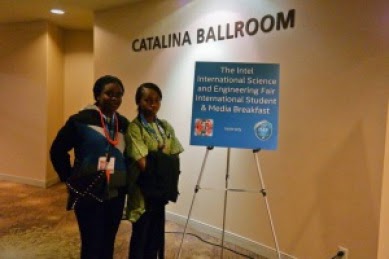Nigerian teenagers at the 2014 Intel International Science and Engineering Fair in Los Angeles, California, USA have done the country proud.
Two 14-year-olds, Eveshorhema Samuel-Alli and Ibukunoluwa Oladeinde, both students of Doregos Private Academy, Ipaja, Lagos, bagged an award for their research on solutions for Halistosia (bad breath). Their award is the Life Science Award of $1,000 in the Medicine and Health Science category, courtesy, Sigma Xi Scientific Research Society.
The trio of Oluwatomisin Osibote, Kpakpando Akaeze and Eveshorhema Samuel-Alli, all 14-year-old SS2 students of same school, improved on a urine-powered generator, replacing the urine with waste oil and ionized water to come up with the 2WP Tri-powered generator which won them $6,000 scholarship, a bronze medal and $150 cash.
WALNUT AS A CURE FOR BAD BREATH
The Halitosis project has to do with mouth odour and Eveshorhema said the idea for the project came while on a school trip to a rural area in Nigeria where the host community served them walnuts.
“When I woke up in the morning, I hadn’t brushed my teeth yet but my breath was already fresh. Then I remembered I had eaten walnuts the previous night.”
To confirm her suspicion, she ate more nuts the following night and awoke with fresh breath again and that made them to carry out further research.
First, the students used a common Nigerian snack, the walnut, to make two different walnut products. They made walnut chewing gum by adding resins and sucrose to chopped walnuts, and a walnut mouthwash by mixing chopped walnut, water and 10 per cent lime as preservative.
According to Eveshorhema Samuel-Alli;
“We conducted this experiment using 35 volunteers who were students of our school. we sent out parents consent forms and when we received the parents’ consent, we continued the experiment. The volunteers were divided into four groups.
One group was given whole walnuts to eat; thev second group was given walnut chewing gum; the third was given walnut mouthwash while the last group was given nothing so they were the control group.
“They took the walnut morning and night. We then observed them and recorded the results. They did not brush their teeth for the duration of the experiment. They were going only on walnut so we would be able to see the improvement.
“After this, we conducted an experiment using Lead tri-oxo nitrate (v) in which the volunteers were made to blow bubbles into a solution of lead nitrate and water before and after the experiment.
“Before they took the walnut and walnut products, they were made to blow bubbles into the solution and then we recorded how long it took to turn the solution black. What turns the solution black is hydrogen sulphide and that is what causes mouth odour.
So if it takes a short time, that means the mouth odour is actually very bad. Then after the experiment, they were also made to blow bubbles into the solution and this time, it was noticed that there was significant time lapse before the solution turned black.
When the control group who had bacteria in their mouths, blew bubbles into the solution, it turned black while it remained clear when the other groups blew bubbles into it. So we knew that the walnut was actually working to cure halitosis.”
THE 2WP TRI-POWERED GENERATOR
A urine-powered generator was created last year by four girls who had thought of how to stop carbon monoxide (CO) from destroying the ecosystem and save lives and also generate free electricity without any obnoxious substances being released. Though their invention worked, many complained about the odour of the urine.
Kpakpando Akaeze says that to improve on the previous technology, the three current researchers first tried to suppress the urine odour with chemicals like sodium carbonate or sea shells, but the odour remained. That was when they got the idea to try other solvents. She says;
“The tri-powered generator is like an evolutionary technology from the urine-powered generator made by our seniors. Rather than looking for other ways to suppress the urine odour, we came up with the tri-powered generator which can work on waste oil, ionized water or urine.
Waste oil is the black oil that is removed from vehicles when they are being serviced. It is processed into butane and propane gases which are then used to power the generator. In our quest to get something similar but different from urine, we came up with the idea of using ionized water.
“Since the urine-powered generator was created through the principle of electrolysis, we also used the same principle to create the tri-powered generator. Urine is a metabolic waste from the body while waste oil and ionized water are mechanical wastes from vehicles and other machines. Now, ionized water consists of 96 per cent water, 2 per cent Sodium Tetraoxosulphate (VI) and 2 per cent Sodium Trioxonitrate (V).
Kudos to these amazing teens!
Read more - Vanguard, and Learning




No comments:
Post a Comment
Click Post a Comment to share your thoughts, I'll love to hear from you. Thanks!
*Comments on old posts are moderated and may take sometime to be shown. That's just because I want to see them and respond to you if necessary.